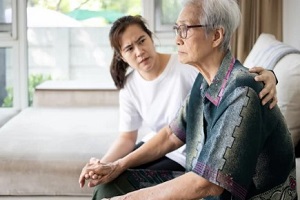 The realm of assisting the elderly seems, at first, to be a noble goal—especially when that older person is a family member. Providing a little extra assistance with basic tasks, devoting half an hour after the workday to keep the house extra clean and remove trip hazards or even keeping track of medications and schedules all seem like minor tasks.
The realm of assisting the elderly seems, at first, to be a noble goal—especially when that older person is a family member. Providing a little extra assistance with basic tasks, devoting half an hour after the workday to keep the house extra clean and remove trip hazards or even keeping track of medications and schedules all seem like minor tasks.
However, over time, the frequency and duration involved in providing such care can result in even loving family members experiencing burnout. This is not a failing on the part of the caregiver.
Instead, here are some things you should know about caregiver burnout, including the symptoms to pay attention for, the dangers of burnout over the long term and how to reduce the risk of burnout when caring for an aging family member.
What Is Caregiver Burnout and What Are the Symptoms?
Caregiver burnout, also referred to as caregiver stress syndrome, is a cluster of symptoms that arise from exhaustion (physical, mental and/or emotional) associated with caring for another person. While it can happen in any kind of care situation, it is most common when assisting the elderly due to the increased number and complexity of tasks they often need help with.
The CDC has reported that almost a quarter of all adults in the US have undertaken caregiver duties for a loved one within the past 30 days, with one in three offering over 20 hours of care per week. Substantial numbers of caregivers reported over 14 mentally or physically unhealthy days over the course of a month, and the CDC labels caregiving as a public health issue.
The symptoms of burnout include physical exhaustion, emotional dullness, sleeplessness, negativity and even hopelessness. It can encourage feelings of anxiety and depression and may cause loving family members to lash out unexpectedly.
The Long-Term Dangers of Burnout
Many families soldier on through caregiver burnout because “it’s temporary.” However, the symptoms associated with caregiver stress syndrome can have long-term effects. The lack of sleep may result in weight gain and an increase in blood pressure, contributing to heart disease.
Physical exhaustion often means that caregivers are not properly taking care of themselves anymore, including eating nutritious meals, staying hydrated and getting enough exercise. In severe cases, the anxiety and depression associated with caregiver burnout can result in suicidal ideation.
However, caregiver burnout does not have to be a consequence of assisting an older loved one as they age in place. Community resources can reduce the impact of consistent care responsibilities and give loved ones a chance to recover from their duties.
Reducing the Risk of Caregiver Burnout
To reduce the risk of burnout and ease the responsibility without compromising the safety and health of an aging individual, the best strategy is to seek help. This can come in the form of visiting nurses, or it can even be the result of free community services like elder transportation. Cutting down on burnout requires carers to address the reasons they are becoming stressed in the first place:
 Skill gaps – When a carer feels that they are not properly skilled in the tasks that their loved one needs help with, this can lead to frustration, anxiety and even physical harm. Loading and unloading a wheelchair or placing a catheter are tasks that benefit from an experienced professional.
Skill gaps – When a carer feels that they are not properly skilled in the tasks that their loved one needs help with, this can lead to frustration, anxiety and even physical harm. Loading and unloading a wheelchair or placing a catheter are tasks that benefit from an experienced professional.- Unclear roles – Taking time to oneself is critical when providing care. Failure to do so blurs the roles that a person inhabits, and they tend to see themselves as a carer first and a spouse, parent or family member second. This erases their identity and leaves them feeling hopeless and overwhelmed.
- Continued decline – Even the best carers cannot eliminate the effects of progressive conditions such as Alzheimer’s. When their loved one continues to get worse despite their best efforts, they can become depressed or attempt to compensate by working harder. This removes the time they need to take care of themselves through exercise, nutrition and relaxation, threatening their health.
Seeking help and tackling the root causes of these reasons behind burnout is the first step toward achieving an appropriate life balance in the face of care duties.
Utilize Community Resources to Ease the Responsibility Load
Taking care of an aging loved one is not an easy task. Family members should make full use of the resources available to them—you do not have to shoulder this challenge alone. The Shepherd’s Center of Northern Virginia assists older adults in their efforts to age safely in place.
An example is our Caregiver Support group, which meets regularly to give caregivers an opportunity to share, learn, and support each other. Contact us to learn about the services in your area that can provide in-home assistance, transportation, community and more so that your loved one is properly cared for without sacrificing your own well-being.
